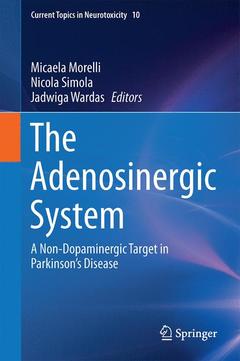Description
The Adenosinergic System, Softcover reprint of the original 1st ed. 2015
A Non-Dopaminergic Target in Parkinson’s Disease
Current Topics in Neurotoxicity Series, Vol. 10
Coordinators: Morelli Micaela, Simola Nicola, Wardas Jadwiga
Language: English
Subject for The Adenosinergic System:
Support: Print on demand
Description
/li>Contents
/li>Biography
/li>Comment
/li>
Adenosine A2A receptors: localization and function.- Allosteric Mechanisms in the adenosine A2A-dopamine D2 receptor heteromer.- Adenosine A2A receptor antagonists in drug development.- Adenosine A2A Receptors and Neurotrophic Factors: Relevance for Parkinson's Disease.- Role of adenosine A2A receptors in the control of neuroinflammation – relevance for Parkinson’s disease.- Purines in Parkinson's: Adenosine A2A receptors and urate as targets for neuroprotection.- Adenosine A2A receptor antagonists as drugs for symptomatic control of Parkinson’s disease in preclinical studies.- Dopamine/adenosine interactions related to tremor in animal models of Parkinsonism.- Adenosine A2A receptor antagonists in L-DOPA-induced motor fluctuations.- Adenosine A2A receptor-mediated control of non-motor functions in Parkinson’s disease.- Imaging Studies with A2A Receptor Antagonists.- Caffeine and neuroprotection in Parkinson's disease.- The story of istradefylline – the first approved A2A antagonist for the treatment of Parkinson’s disease.- Adenosinergic Receptor Antagonists: Clinical Experience in Parkinson's Disease.- Adenosinergic regulation of sleep-wake behavior in the basal ganglia.
Micaela Morelli is a Professor of Pharmacology in the Department of Biomedical Sciences at the University of Cagliari. She also belongs to the Institute of Neuroscience at the National Research Council of Italy (CNR), the Center of Excellence for Neurobiology of Dependence at the University of Cagliari and is a member of the PhD school in Neuroscience at the University of Cagliari. Professor Morelli served in the Governing Councils of the Italian Neuroscience Society (SINS) and the International Basal Ganglia Society (IBAGS). Since 2005, she has been the Italian representative in the International Brain Research Organization (IBRO), and since 2010 she has been a member of the IBRO WERC/PERC Governing Council. Her main subjects of investigation focus on the mechanism of action of drugs affecting dopaminergic and adenosinergic transmission and their interaction in rodent models of Parkinson's disease.
Dr. Nicola Simola holds a M.S. in Pharmaceutical Chemistry and a Ph. D in Pharmacology of Drug Dependence and he is currently Assistant Professor of Pharmacology at the Department of Biomedical Sciences at the University of Cagliari. Dr. Simola’s research involves the study and development of new therapeutic agents for the treatment of Parkinson’s disease, focusing on adenosine receptor antagonists, the development of new preclinical models of early-stage Parkinson’s disease and the study of the interactions between caffeine and other recreational psychostimulants. Moreover, a recent field of Dr Simola’s research focuses on the study of ultrasonic vocalizations in rats as a tool for the study of the addictive properties of drugs.
Jadwiga Wardas Ph.D., graduated from the Jagiellonian University in Krakow, Poland with an MSc in biology. In 1988 she was granted a fellowship from the National Academy of Sciences, USA. She holds a Ph.D. in Life Sciences from the Institute of Pharmacology, Polish Academy of Sciences (IPh PAN). She served as
Associate ProfesComprehensive book that discusses all the aspects of this class of drugs in relation to Parkinson's Disease
Includes a review on the history of istradefylline
Includes a review on urate as a biomarker and neuroprotectant
Includes supplementary material: sn.pub/extras




